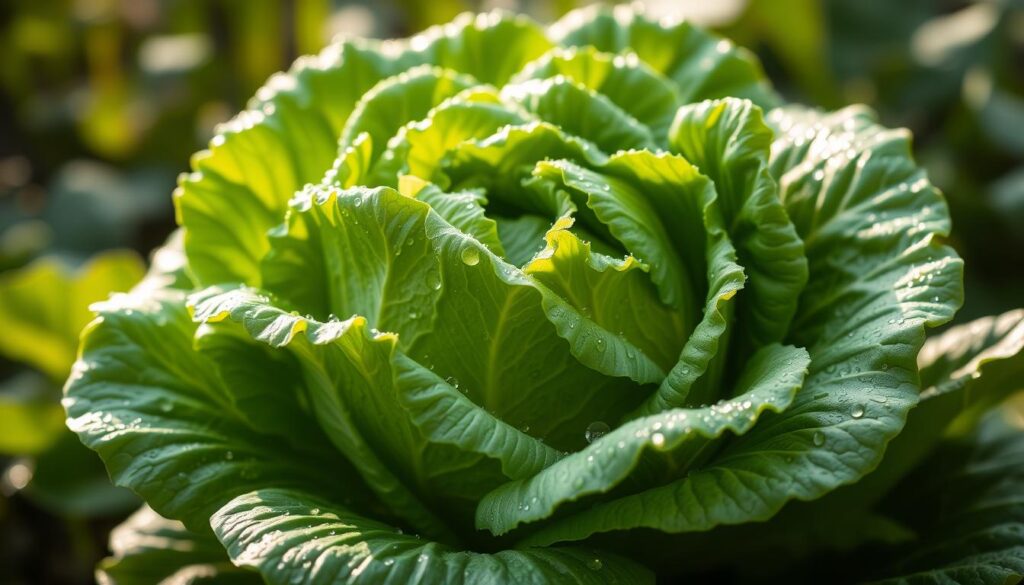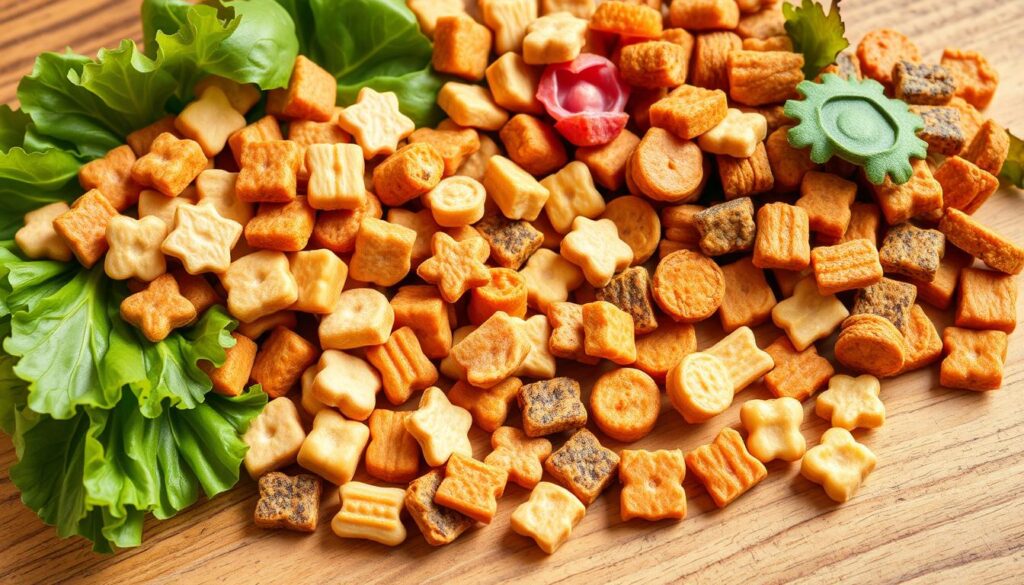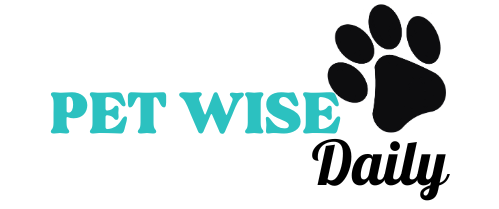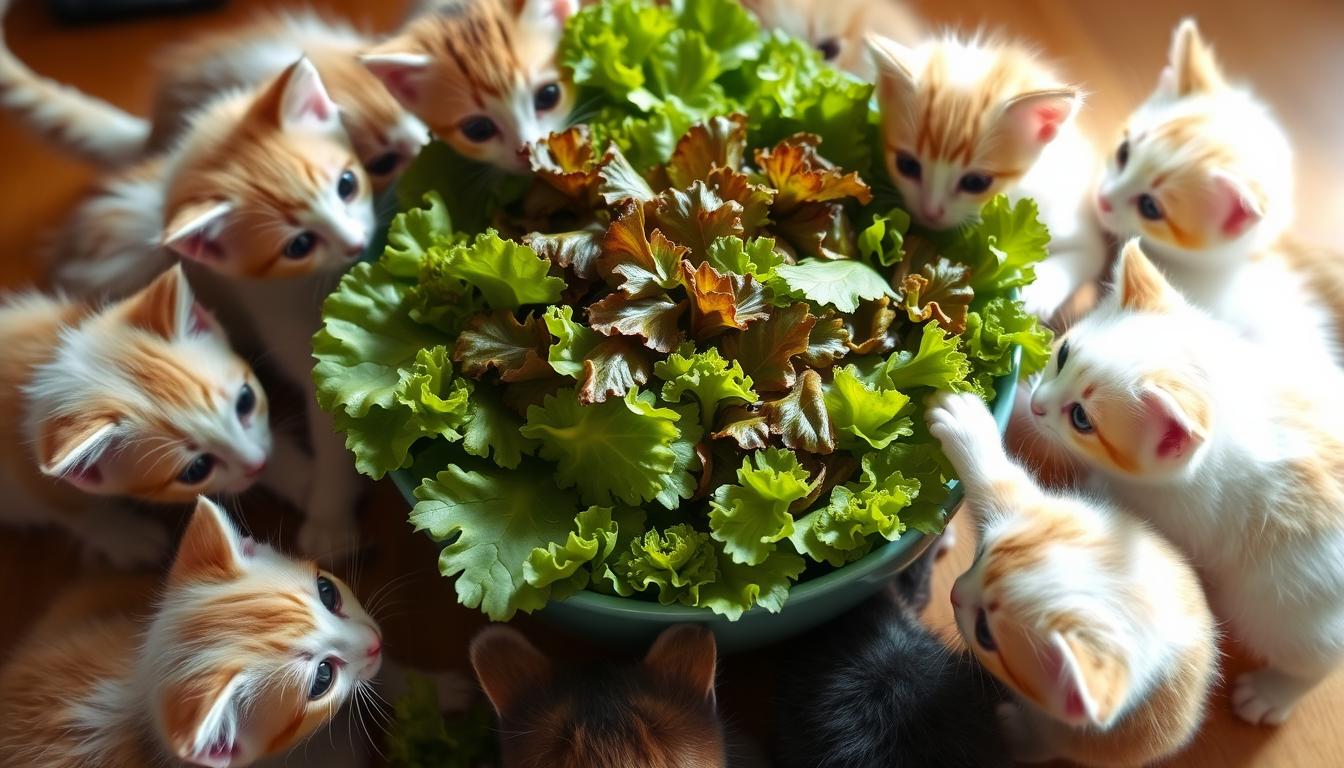Ever thought about letting your cat try lettuce? It’s a common question for pet owners. The good news is that, in small amounts, lettuce can be good for your cat. This guide will help you understand how lettuce fits into your cat’s diet.
Table of Contents
Understanding Feline Nutritional Requirements
Cats are obligate carnivores, needing animal-based proteins to survive. Nutrients like taurine, arginine, and methionine are key for their heart, eyes, skin, and health.
Essential Nutrients for Carnivorous Cats
Cats need amino acids, vitamins, and minerals found mainly in animal products. These include:
- Taurine – Crucial for cardiac health, reproduction, and vision
- Arginine – Necessary for removing ammonia, vital for well-being
- Methionine – Essential for proper coat condition and taurine synthesis
- Vitamin A – Supports vision, immune function, growth, and skin health
- Niacin – Aids in energy production, skin health, and metabolic processes
- Vitamin B12 – Required for red blood cell formation, neurological function, and DNA synthesis
The Role of Animal Protein in Cat Diet
Cats can’t easily get nutrients from plants. As obligate carnivores, they need animal proteins for health. These proteins give them the amino acids, vitamins, and minerals they need.
“Cats are carnivores, so they require a diet that is high in animal-derived proteins to meet their nutritional needs.”
Choosing a balanced, high-quality cat food is key. It should have the right mix of animal proteins, fats, and nutrients. This supports your cat’s health and meets their natural dietary needs.
Can Cats Have Lettuce: Safety and Benefits
Cats can safely eat lettuce in small amounts. It’s not a big source of nutrients for them, but it can be good in moderation.
Lettuce is low in calories and has fiber, vitamins, and minerals. It has potassium for blood pressure, folate for red blood cells, and vitamin C for the immune system. Vitamin K helps with blood clotting, and vitamin A is good for growth and vision.
Lettuce also has fiber, which is good for digestion. But, iceberg lettuce has a lot of water. Eating too much can cause diarrhea.
| Lettuce Variety | Nutritional Benefits for Cats |
|---|---|
| Romaine Lettuce | Contains vitamins K and C, phosphorus, magnesium, and potassium, making it a suitable option for cats. |
| Buttercrunch Lettuce | Rich in calcium, vitamins A, K, and C, as well as iron, making it a good choice for cats. |
| Green Leaf Lettuce | High in vitamin A, so it should be offered sparingly to cats. |
Lettuce has some benefits, but it can’t replace a balanced diet for cats. Cats need animal protein more than plant-based foods. Lettuce lacks important nutrients like taurine and vitamin A.
Wash lettuce well before giving it to your cat. Tear or chop it to avoid choking. Cats only need a little lettuce each week for its benefits.
While cats can eat lettuce, watch how they react. Talk to your vet if you see any bad effects. Eating too much lettuce can cause health problems.
Types of Lettuce Safe for Cats
Cats are meat-eaters, but some leafy greens are okay for them in small amounts. Lettuce varieties like iceberg, romaine, butter, and green leaf are good for cats.
Iceberg Lettuce for Cats
Iceberg lettuce is good for cats because it’s full of water. This helps keep them hydrated. But, it doesn’t have many nutrients like vitamins, minerals, or fiber.
Romaine and Butter Lettuce Options
Romaine and butter lettuce are better for cats than iceberg. Romaine has minerals like magnesium and potassium. Butter lettuce has vitamins A, C, and K, which are good for health.
Green Leaf Lettuce Benefits
Green leaf lettuce is safe for cats too. It has folate, calcium, and fiber. These help with digestion and the immune system.
When adding lettuce to your cat’s diet, do it slowly and in small amounts. Too much can upset their stomach. Make sure to wash the lettuce well to remove pesticides.
| Lettuce Type | Nutritional Benefits | Potential Concerns |
|---|---|---|
| Iceberg Lettuce | High water content | Low in essential nutrients |
| Romaine Lettuce | Magnesium, potassium | Moderate nutrient profile |
| Butter Lettuce | Vitamins A, C, K | Mild sedative effects |
| Green Leaf Lettuce | Folate, calcium, fiber | Potential digestive issues |
Knowing which lettuce is safe and good for cats helps you feed them well. You can add these greens to their diet in a healthy way.
Nutritional Value of Lettuce for Cats
Lettuce is not a big deal for cats when it comes to nutrition. It has some vitamins and minerals, but not enough to really help a cat’s diet. A 100-gram serving of lettuce has about 15 calories, 0.2g of fat, and 1.4g of protein. This makes it a low-calorie, low-nutrient choice for cats.
Cats need animal-based proteins to stay healthy. They need taurine, arginine, and methionine for their heart, eyes, and fur. These nutrients are mostly found in meat, not in plants like lettuce.
Vegetables can add fiber, vitamins, and minerals to a cat’s diet. But, they shouldn’t be the main food. Foods like sweet potatoes, carrots, peas, and pumpkin are better for cats than lettuce.
| Nutrient | Amount in 100g Lettuce | Recommended Daily Intake for Cats |
|---|---|---|
| Calories | 15 | 20-35 kcal/lb of body weight |
| Fat | 0.2g | 5-20% of total calories |
| Protein | 1.4g | 25-30% of total calories |
| Fiber | 1.3g | 1.5-3.5% of dry matter intake |
Lettuce can help with hydration and fiber for cats. But, it’s not a big part of their diet. It’s important to not give too much lettuce to cats. Too much can upset their stomachs because of its water and mild sedative effects.
Health Benefits of Feeding Lettuce to Cats
Lettuce is not packed with nutrients for cats, but it has some small health perks. It’s full of water, which helps keep your cat hydrated. This is especially good for cats that don’t drink enough water. The fiber in lettuce also helps with digestion and prevents constipation.
Hydration Benefits
Cats can be picky about drinking water. Lettuce’s water content can help fill this gap. It supports your cat’s health and prevents dehydration. But, remember, lettuce should not be the only source of water for your cat.
Fiber Content and Digestive Health
The fiber in lettuce helps with regular bowel movements and prevents constipation. Even though it’s not as much as in other veggies, it’s still beneficial. Just don’t give too much, as it can upset your cat’s stomach.
Feeding lettuce to cats has very minor health benefits. It should not replace a balanced diet or fresh water. Lettuce can be a fun treat sometimes, but it shouldn’t be a big part of your cat’s diet.
Potential Risks and Side Effects
Lettuce can be good for your cat, but there are risks and side effects. Too much lettuce can cause diarrhea or upset stomach. Some cats might also react to certain types of lettuce.
Choking is another risk if your cat eats big lettuce pieces. Make sure to wash the lettuce well. This removes harmful pesticides or chemicals that could harm your pet.
Also, some lettuce, like Romaine, can cause vitamin A toxicity in cats. This can lead to serious health issues. So, it’s important to not overdo it with lettuce in your cat’s diet.
“It’s important to introduce lettuce gradually to your cat and monitor their reaction to ensure there are no adverse effects.”
Knowing these risks helps you feed lettuce safely to your cat. This way, you can keep their pet care tips, veterinary advice, and cat health concerns in mind.

Proper Preparation and Serving Size
Feeding lettuce to your cat needs careful preparation. Make sure to wash the lettuce well to remove pesticides or debris. Cut it into small pieces to avoid choking hazards. Cats should only have 1-2 small leaves (about 5-8 grams) once a week.
Washing and Cleaning Guidelines
Before giving lettuce to your cat, rinse it under water to get rid of dirt and chemicals. Don’t use soap or detergents, as they can be harmful. Pat the lettuce dry with a clean towel or paper towel to remove extra moisture.
Recommended Portions
- Serve no more than 1-2 small lettuce leaves per feeding, once a week.
- Ensure the lettuce is fresh and not wilted or spoiled.
- Never add any seasonings, dressings, or other additives to the lettuce.
Feeding lettuce to your cat should be done in moderation. Stick to the recommended sizes and frequency to avoid digestive issues or health problems.
“Feeding your cat a balanced diet that includes the right amount of protein, fat, and carbohydrates is essential for their overall health and well-being.”
Remember, cats are meat-eaters and need a diet rich in animal proteins. While lettuce is a safe treat, it should not replace their regular cat food.
Signs Your Cat Should Not Eat Lettuce
Lettuce can be good for cats because it helps with hydration. But, not all cats can eat it safely. It’s important to get vet advice and know your cat’s health needs.
If your cat has allergies or can’t digest certain foods, they should not eat lettuce. Look out for signs like vomiting, diarrhea, or loss of appetite after they eat lettuce. Cats with health issues or on special diets should talk to a vet before trying lettuce.
Also, if your cat doesn’t like lettuce, don’t make them eat it. It’s key to respect their food choices for their health and your bond with them.
“Cats have a unique metabolism designed to efficiently utilize protein as their main source of energy. Introducing new foods, like lettuce, should be done with caution to ensure they don’t cause any adverse effects.”
Pay attention to your cat’s cat health concerns and follow vet advice. This way, you can keep their diet balanced and avoid lettuce risks. Tailoring pet care to your cat’s needs is the best way to keep them healthy and happy.
Incorporating Lettuce into Your Cat’s Diet
As a responsible pet parent, you might wonder how to safely add lettuce to your cat’s diet. Lettuce can be nutritious, but you should be careful and thoughtful about it.
Creative Serving Suggestions
Start with small amounts of lettuce and watch how your cat reacts. You can chop lettuce finely and add it to their regular food. Or, use lettuce leaves to wrap a bit of wet food, making a tasty, healthy snack.
Mixing with Regular Cat Food
Another way to add lettuce is by mixing it into their meals. Chop or shred the lettuce and sprinkle it over their kibble or canned food. This adds hydration, fiber, and nutrients. Just keep an eye on how much they eat and adjust as needed.
Remember, lettuce should not be the main food for your cat. Their main diet should be a balanced, high-quality cat food made for their nutritional needs.

When introducing new foods, watch your cat closely. Some cats might not like lettuce’s taste or texture. If they show signs of upset stomach or loss of appetite, stop giving them lettuce and talk to your vet.
Adding lettuce to your cat’s diet in small amounts can be a healthy treat. It can add hydration and nutrients. But, always talk to your vet before making big changes to their diet.
When to Consult a Veterinarian
It’s always wise to talk to a vet before changing your cat’s diet, like adding lettuce. Lettuce can be good for cats, but it must be given safely and in small amounts. This helps avoid health problems.
If your cat has an allergic reaction, keeps having digestive issues, or acts strangely after eating lettuce, get vet help right away. A vet can give you veterinary advice that fits your cat’s needs. They help you find the best pet care tips for your cat.
- Consult a veterinarian before making any major changes to your cat’s diet, including adding lettuce.
- Seek immediate veterinary care if your cat exhibits signs of an allergic reaction, digestive problems, or unusual behavior after eating lettuce.
- A veterinarian can offer tailored guidance on your cat’s dietary needs and ensure the safe introduction of new foods.
Keeping your cat healthy is key. Getting veterinary advice is the best way to make sure your cat gets the right food and care.
“Consulting a veterinarian is the surest way to ensure your cat’s dietary needs are met and any potential health concerns are addressed promptly.”
Alternative Vegetables for Cats
Lettuce is okay for cats sometimes, but other veggies are better. Cooked carrots, green beans, or pumpkin are great for your cat’s diet.
Carrots are safe and full of fiber, vitamins, and minerals. They help keep your cat healthy. Make sure to cook them first because raw carrots can be a choking hazard. Green beans are also safe and low in calories. They’re full of vitamins A and C, and minerals too.
- Cooked carrots
- Green beans
- Pumpkin (plain, unsweetened)
These cat-safe vegetables are better than lettuce for your cat. They can be part of their cat food ingredients as healthy cat treats. But, add new foods slowly and in small amounts. They shouldn’t replace your cat’s main diet.
| Vegetable | Nutritional Benefits for Cats | Preparation Tips |
|---|---|---|
| Carrots | High in fiber, vitamins, and minerals | Cook thoroughly to soften |
| Green Beans | Rich in vitamins A and C, as well as essential minerals | Lightly steam or sauté |
| Pumpkin | Excellent source of fiber and beta-carotene | Offer plain, unsweetened pumpkin puree |
These cat-safe vegetables are good for your cat’s diet, but only in small amounts. They shouldn’t replace their main cat food ingredients. Always talk to your vet before adding new healthy cat treats to your cat’s diet.
Conclusion
In conclusion, cats can safely eat lettuce in moderation. Lettuce has little nutritional value but can help with hydration and fiber. It should not replace a balanced diet rich in meat for your cat’s needs.
Always prepare lettuce right, introduce it slowly, and watch how your cat reacts. If you’re unsure, talk to a vet for advice on adding veggies to your cat’s diet. This way, you can make sure your cat gets a balanced and healthy diet.
Remember, cats need to eat mainly animal proteins because they are meat-eaters. Lettuce and veggies can be treats but not the main food. With the right steps, you can add lettuce safely to your cat’s diet.
Knowing the good and bad of lettuce for cats helps you make better choices for their health. Talk to your vet, watch your cat’s health, and change their diet if needed. This will keep your cat happy, healthy, and thriving.


1 thought on “Can Cats Have Lettuce: Safe Feeding Guide for Felines”